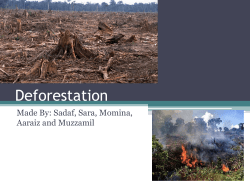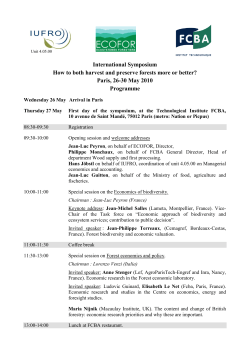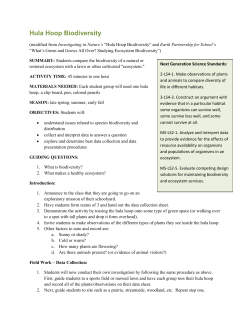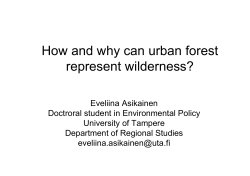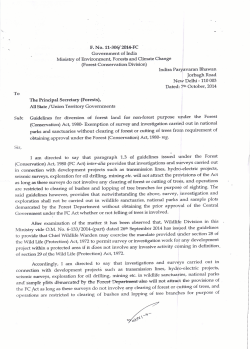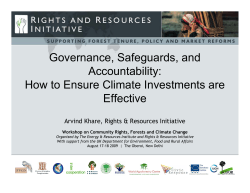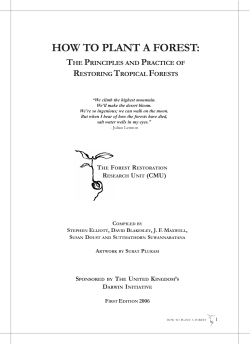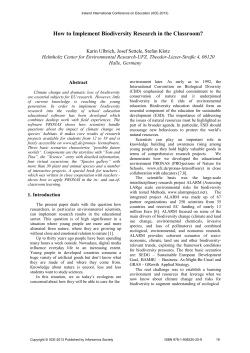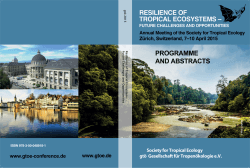
Sustaining Biodiversity: The Ecosystem Approach Chapter 9
Sustaining Biodiversity: The Ecosystem Approach Chapter 9 Section 9-1 WHAT ARE THE MAJOR THREATS TO FOREST ECOSYSTEMS? Forests vary in their age, makeup, and origins • Natural and planted forests occupy about 30% of the earth’s land surface (excluding Greenland and Antarctica). • Two major types based on their age and structure: – Old growth forest: Uncut or regenerated primary forest that has not been seriously disturbed by human activities or natural disasters for several hundred years or more. – Second-growth forest: A stand of trees resulting from secondary ecological succession that develops after the trees in an area have been removed by human activities such as clear-cutting for timber or cropland or by natural forces such as fire, hurricanes, or volcanic eruption. Forests vary in their age, makeup, and origins • A tree plantation (tree farm, commercial forest), is a managed tract with uniformly aged trees of one or two genetically uniform species that usually are harvested by clear-cutting as soon as they become commercially valuable. • Forests provide important economic and ecological services. – Forests remove CO2 from the atmosphere and store it in organic compounds (biomass) through photosynthesis. – Forests help to stabilize the earth’s temperature and slow projected climate change. The short rotation cycle of cutting and regrowth of a monoculture tree plantation Weak trees removed 25 yrs Clear cut 30 yrs 15 yrs Years of growth Seedlings planted 5 yrs 10 yrs Fig. 9-3a, p. 176 Forests provide many important economic and ecological services Unsustainable logging is a major threat to forest ecosystems • The first step in harvesting trees is to build roads for access and timber removal, but they can cause the following problems: – Increased erosion and sediment runoff into waterways. – Habitat fragmentation. – Loss of biodiversity. – Forest exposure to invasion by nonnative pests, diseases, and wildlife species. Unsustainable logging is a major threat to forest ecosystems • Methods of harvesting trees: – Selective cutting. – Clear-cut. – Strip cutting. Three major tree harvesting methods (a) Selective cutting Clear stream Fig. 9-6a, p. 179 (b) Clear-cutting Muddy stream Fig. 9-6b, p. 179 (c) Strip cutting Uncut Cut 1 year ago Dirt road Cut 3–10 years ago Uncut Clear stream Fig. 9-6c, p. 179 Aerial view showing clear-cut logging, Washington state Fire can threaten or benefit forest ecosystems • Surface fires usually burn only undergrowth and leaf litter on the forest floor. – Kills seedlings and small trees but spares most mature trees and allows most wild animals to escape. – Burns away flammable ground material and may help to prevent more destructive fires. – Frees valuable mineral nutrients tied up in slowly decomposing litter and undergrowth. Fire can threaten or benefit forest ecosystems – Releases seeds from the cones of lodgepole pines. – Stimulates the germination of certain tree seeds (e.g. giant sequoia and jack pine). – Helps to control tree diseases and insects. • Crown fires are extremely hot fires that leap from treetops, burning whole trees. – Can destroy most vegetation, kill wildlife, increase soil erosion, and burn or damage human structures in their paths. Surface fires and crown fires Almost half of the world’s forests have been cut down • Deforestation is the temporary or permanent removal of large expanses of forest for agriculture, settlements, or other uses. • Human activities have reduced the earth’s original forest cover by about 46%, with most of this loss occurring in the last 60 years. • If current deforestation rates continue, about 40% of the world’s remaining intact forests will have been logged or converted to other uses within two decades, if not sooner. Almost half of the world’s forests have been cut down • Clearing large areas of forests, especially old-growth forests, has important short-term economic benefits, but it also has a number of harmful environmental effects. • The net total forest cover in several countries changed very little or even increased between 2000 and 2007. Some due to natural reforestation by secondary ecological succession on cleared forest areas and abandoned croplands, or the spread of tree plantations. • Concern about the growing amount of land occupied by commercial tree plantations, because replacement of old-growth forests by these biologically simplified tree farms represents a loss of biodiversity, and possibly of stability, in some forest ecosystems. Harmful effects of deforestation CASE STUDY: Many Cleared Forests in the United States Have Grown Back • Forests that cover about 30% of the U.S. land area provide habitats for more than 80% of the country’s wildlife species and supply about two-thirds of the nation’s surface water. • Today, forests in the U.S. cover more area than they did in 1920, primarily due to secondary succession. • Every year, more wood is grown in the U.S. than is cut and the total area planted with trees increases. • Protected forests make up about 40%. • Since the mid-1960s, an increasing area of the nation’s remaining old-growth and fairly diverse second-growth forests has been cut down and replaced with biologically simplified tree plantations. Forest cover in the U.S. Tropical forests are disappearing rapidly • Tropical forests cover about 6% of the earth’s land area. • At least half of the world’s known species of terrestrial plants and animals live in tropical forests. • Brazil has more than 30% of the world’s remaining tropical rain forest in its vast Amazon basin. • At the current rate of global deforestation, 50% of the world’s remaining old-growth tropical forests will be gone or severely degraded by the end of this century. Causes of tropical deforestation are varied and complex • There are a number of interconnected underlying and direct causes. – Pressures from population growth and poverty, push subsistence farmers and the landless poor into tropical forests, where they try to grow enough food to survive. – Government subsidies can accelerate the direct causes such as logging and ranching by reducing the costs of timber harvesting, cattle grazing, and the creation of vast plantations of crops such as soybeans. Causes of tropical deforestation are varied and complex – Tropical forests in the Amazon and other South American countries are cleared/burned for cattle grazing and large soybean plantations. – In Southeast Asia, tropical forests are being replaced with vast plantations of oil palm, whose oil is used in cooking, cosmetics, and biodiesel fuel for motor vehicles. – In Africa, people struggle to survive by clearing plots for small-scale farming and by harvesting wood for fuel, which is causing deforestation on that continent. Major underlying and direct causes of the destruction and degradation of tropical forests Section 9-2 HOW SHOULD WE MANAGE AND SUSTAIN FORESTS? We can manage forests more sustainably • Certification of sustainably grown timber and of sustainably produced forest products can help consumers. • Removing government subsidies and tax breaks that encourage deforestation would also help. Ways to grow and harvest trees more sustainably We can improve the management of forest fires • In the United States, the Smokey Bear educational campaign has: – prevented countless forest fires, saved many lives and prevented billions of dollars in loss of trees, wildlife, and human structures. – convinced the public that all forest fires are bad and should be prevented or put out. • Trying to prevent all forest fires can make matters worse by increasing the likelihood of destructive crown fires due to the accumulation of highly flammable underbrush and smaller trees in some forests. We can improve the management of forest fires • Strategies for reducing fire-related harm: – Prescribed burns are small, contained surface fires to remove flammable small trees and underbrush in the highest-risk forest areas. – Allow some fires on public lands to burn, thereby removing flammable underbrush and smaller trees, as long as the fires do not threaten human structures and life. Protect houses/buildings in fire-prone areas by thinning a zone of about 60 meters (200 feet) around them and eliminating the use of flammable building materials such as wooden shingles. – Thin fire-prone areas by clearing small fire-prone trees and underbrush under careful environmental controls. We can reduce the demand for harvested trees • Reduce inefficient use of construction materials, excess packaging, overuse of junk mail, inadequate paper recycling, and failure to reuse or find substitutes for wooden shipping containers. • Paper can be made from fiber that does not come from trees. Ways to reduce tropical deforestation • Debt-for-nature swap can make it financially attractive for countries to protect their tropical forests. • Conservation concessions occur when governments or private conservation organizations pay nations for agreeing to preserve their natural resources. Ways to reduce tropical deforestation • Consumers can reduce the demand for products that are supplied through illegal and unsustainable logging in tropical forests. – For building projects, use recycled waste lumber or wood alternatives, such as recycled plastic building materials and bamboo. – Reduce the use of throwaway paper products and replace them with reusable plates, cups, and cloth napkins and handkerchiefs. • Individuals can plant trees. Ways to protect tropical forests and use them more sustainably Section 9-3 HOW SHOULD WE MANAGE AND SUSTAIN GRASSLANDS? Some rangelands are overgrazed • Grasslands provide many important ecological services, including soil formation, erosion control, nutrient cycling, storage of atmospheric carbon dioxide in biomass, and maintenance of biodiversity. • Rangelands are unfenced grasslands in temperate and tropical climates that supply forage, or vegetation, for grazing (grass-eating) and browsing (shrub-eating) animals. Some rangelands are overgrazed • Livestock also graze in pastures, which are managed grasslands or enclosed meadows usually planted with domesticated grasses or other forage. • Overgrazing occurs when too many animals graze for too long and exceed the carrying capacity of a rangeland area. • Limited data from surveys in various countries indicate that overgrazing by livestock has caused a loss in productivity in as much as 20% of the world’s rangeland. Left of fence: overgrazed land Right: lightly grazed land We can manage rangelands more sustainably • Control the number of grazing animals and the duration of their grazing in a given area so the carrying capacity of the area is not exceeded. – Rotational grazing: confine cattle to one area via portable fencing for a short time (1–2 days) and then moved. – Provide supplemental feed at selected sites and strategically locate water holes and tanks and salt blocks to reduce overgrazing. – Suppress the growth of unwanted invader plants by use of herbicides, mechanical removal, or controlled burning or use controlled, short-term trampling by large numbers of livestock. Restoration via secondary ecological succession Section 9-4 HOW SHOULD WE MANAGE AND SUSTAIN PARKS AND NATURE RESERVES? National parks face many environmental threats • More than 1,100 major national parks are located in more than 120 countries. • Most too small to sustain many large animal species. • Many parks suffer from invasions by nonnative species that compete with and reduce the populations of native species. • Some parks are so popular that large numbers of visitors are degrading the natural features that make them attractive. • Parks in less-developed countries have the greatest biodiversity of all parks, but only about 1% of these parklands are protected. CASE STUDY: Stresses on U.S. Public Parks • The U.S. national park system, established in 1912, includes 58 major national parks, along with 335 monuments and historic sites. States, counties, and cities also operate public parks. • Popularity is one of the biggest problems. Noisy and polluting vehicles degrade the aesthetic experience for many visitors, destroy or damage fragile vegetation, and disturb wildlife. • Many suffer damage from the migration or deliberate introduction of nonnative species. • Native species—some of them threatened or endangered—are killed or removed illegally. Nature reserves occupy only a small part of the earth’s land • As of 2010, less than 13% of the earth’s land area was strictly or partially protected in nature reserves, parks, wildlife refuges, wilderness, and other areas. • No more than 5% of the earth’s land is strictly protected from potentially harmful human activities. • Conservation biologists call for full protection of at least 20% of the earth’s land area in a global system of biodiversity. • Developers and resource extractors oppose protection and contend that these areas might contain valuable resources that would add to current economic growth. Nature reserves occupy only a small part of the earth’s land • Ecologists and conservation biologists view protected areas as islands of biodiversity and natural capital that help to sustain all life and economies and serve as centers of evolution. • The buffer zone concept strictly protects an inner core of a reserve and establishes buffer zones in which local people can extract resources sustainably without harming the inner core. • By 2010, the United Nations had used this principle to create a global network of 553 biosphere reserves in 109 countries. CASE STUDY: Costa Rica—A Global Conservation Leader • Tropical forests once completely covered Costa Rica, but between 1963 and 1983 much of the country’s forests were cleared to graze cattle. • Costa Rica is a superpower of biodiversity, with an estimated 500,000 plant and animal species. • Costa Rica now has a system of nature reserves and national parks that, by 2010, included about a quarter of its land. • Costa Rica now devotes a larger proportion of its land to biodiversity conservation than does any other country CASE STUDY: Costa Rica—A Global Conservation Leader • The country’s largest source of income is its $1billion-a-year tourism industry, almost two-thirds of which involves ecotourism. • To reduce deforestation, the government has cut subsidies for converting forest to rangeland. • The government pays landowners to maintain or restore tree cover. • Between 2007 and 2008, the government planted nearly 14 million trees. • Went from having one of the world’s highest deforestation rates to having one of the lowest. Costa Rica’s eight megareserves Nicaragua Caribbean Sea Costa Rica Panama Pacific Ocean National parkland Buffer zone Fig. 9-20, p. 191 Protecting wilderness is an important way to preserve biodiversity • One way to protect undeveloped lands is to set them aside as wilderness, land officially designated as an area where natural communities have not been seriously disturbed by humans and where human activities are limited by law. • Some critics oppose protecting large areas for their scenic and recreational value for a relatively small number of people. • Conservation biologists support protecting wilderness in order to preserve biodiversity and as centers for evolution. CASE STUDY: Controversy over Wilderness Protection in the United States • Conservationists have been trying to save wild areas from development since 1900. • The Wilderness Act (1964) allowed the government to protect undeveloped tracts of public land from development as part of the National Wilderness Preservation System. • Only about 2% of the land area of the lower 48 states is protected, most of it in the West. Section 9-5 WHAT IS THE ECOSYSTEM APPROACH TO SUSTAINING BIODIVERSITY? Here are four ways to protect ecosystems • Most biologists and wildlife conservationists believe that the best way to keep from hastening the extinction of wild species through human activities is the ecosystems approach, which protects threatened habitats and ecosystem services. Here are four ways to protect ecosystems • Four-point plan of the ecosystems approach: – Map the world’s terrestrial and aquatic ecosystems and create an inventory of the species contained in each of them and the ecosystem services they provide. – Locate and protect the most endangered ecosystems and species, with emphasis on protecting plant biodiversity and ecosystem services. – Seek to restore as many degraded ecosystems as possible. Protecting global biodiversity hotspots is an urgent priority • Some biodiversity scientists urge adoption of an emergency action strategy to identify and quickly protect biodiversity hotspots, areas especially rich in plant species that are found nowhere else and are in great danger of extinction . • These hotspots cover only a little more than 2% of the earth’s land surface, they contain an estimated 50% of the world’s flowering plant species and 42% of all terrestrial species. • These hotspots are home for a large majority of the world’s endangered or critically endangered species, and one-fifth of the world’s population. Biodiversity hotspots We can rehabilitate and restore ecosystems that we have damaged • Almost every natural place on the earth has been affected or degraded to some degree by human activities. • We can at least partially reverse much of this harm through ecological restoration: the process of repairing damage caused by humans to the biodiversity and dynamics of natural ecosystems. • Examples of restoration include: – replanting forests We can rehabilitate and restore ecosystems that we have damaged – restoring grasslands – restoring coral reefs – restoring wetlands and stream banks – reintroducing native species – removing invasive species – freeing river flows by removing dams. We can rehabilitate and restore ecosystems that we have damaged • Four steps to speed up repair operations include the following: – Restoration. – Rehabilitation. – Replacement. – Creating artificial ecosystems. We can rehabilitate and restore ecosystems that we have damaged • Researchers have suggested a science-based, four-step strategy for carrying out most forms of ecological restoration and rehabilitation: – Identify the causes of the degradation. – Stop the abuse by eliminating or sharply reducing these factors. – If necessary, reintroduce key species to help restore natural ecological processes. – Protect the area from further degradation and allow secondary ecological succession to occur. We can share areas we dominate with other species • Reconciliation ecology is the science that focuses on inventing, establishing, and maintaining new habitats to conserve species diversity in places where people live, work, or play. • Examples include: – Protecting local wildlife and ecosystems can provide economic resources for their communities by encouraging sustainable forms of ecotourism. We can share areas we dominate with other species – Protecting vital insect pollinators such as native butterflies and bees by reducing the use of pesticides, planting flowering plants as a source of food for pollinating insect species, and building structures which serve as hives for pollinating bees. – Protecting bluebirds within human-dominated habitats where most of the bluebirds’ nesting trees have been cut down by using nesting boxes and keeping house cats away from nesting bluebirds. Ways you can help sustain terrestrial biodiversity Section 9-6 HOW CAN WE HELP TO SUSTAIN AQUATIC BIODIVERSITY? Human activities are destroying and degrading aquatic biodiversity • Human activities have destroyed or degraded a large portion of the world’s coastal wetlands, coral reefs, mangroves, and ocean bottom, and disrupted many of the world’s freshwater ecosystems. • Rising sea levels are likely to destroy many coral reefs and flood some low-lying islands along with their protective coastal mangrove forests. • Loss and degradation of many sea-bottom habitats caused by dredging operations and trawler fishing boats. Human activities are destroying and degrading aquatic biodiversity • In freshwater aquatic zones, dam building and excessive water withdrawal from rivers for irrigation and urban water supplies destroy aquatic habitats, degrade water flows, and disrupt freshwater biodiversity. • The deliberate or accidental introduction of hundreds of harmful invasive species threatens aquatic biodiversity. • Thirty-four percent of the world’s known marine fish species and 71% of the world’s freshwater fish species face premature extinction. Before and after a trawler net Overfishing: gone fishing; fish gone • A fishery is a concentration of a particular wild aquatic species suitable for commercial harvesting in a given ocean area or inland body of water. • The fishprint is defined as the area of ocean needed to sustain the consumption of an average person, a nation, or the world. • Fifty-two percent of the world’s fisheries are fully exploited, 20% are moderately overexploited, and 28% are overexploited or depleted. Overfishing: gone fishing; fish gone • Overharvesting has led to the collapse of some of the world’s major fisheries. • When overharvesting causes larger predatory species to dwindle, rapidly reproducing invasive species can more easily take over and disrupt ocean food webs. The collapse of Canada’s 500year-old Atlantic cod fishery 900,000 800,000 Fish landings (tons) 700,000 600,000 500,000 400,000 1992 300,000 200,000 100,000 0 1900 1920 1940 1960 Year 1980 2000 Fig. 9-25, p. 197 CASE STUDY: Industrial Fish Harvesting Methods • Industrial fishing fleets dominate the world’s marine fishing industry, using global satellite positioning equipment, sonar fish-finding devices, huge nets and long fishing lines, spotter planes, and gigantic refrigerated factory ships that can process and freeze their catches. • Trawler fishing is used to catch fish and shellfish by dragging a funnel-shaped net held open at the neck along the ocean bottom. • Purse-seine fishing, is used to catch surface-dwelling fish by using a spotter plane to locate a school; the fishing vessel then encloses it with a large net called a purse seine. CASE STUDY: Industrial Fish Harvesting Methods • Longlining involves lines up to 130 kilometers (80 miles) long, hung with thousands of baited hooks to catch open-ocean fish species or bottom fishes. • Drift-net fishing catches fish with huge drifting nets that can hang as deep as 15 meters (50 feet) below the surface and extend to 64 kilometers (40 miles) long. • Drift-nets can trap and kill large quantities of unwanted fish, called bycatch, along with marine mammals, sea turtles, and seabirds. • Almost one-third of the world’s annual fish catch by weight consists of bycatch species, which are mostly thrown overboard dead or dying. Major commercial fishing methods Fish farming in cage Trawler fishing Spotter airplane Purse-seine Sonar fishing Drift-net fishing Long line fishing Float Buoy lines with hooks Deep sea aquaculture cage Fish caught by gills Fig. 9-26, p. 198 We can protect and sustain marine biodiversity • Protecting marine biodiversity is difficult for several reasons. – The human ecological footprint and fishprint are expanding so rapidly into aquatic areas that it is difficult to monitor the impacts. – Much of the damage to the oceans and other bodies of water is not visible to most people. We can protect and sustain marine biodiversity – Many people incorrectly view the seas as an inexhaustible resource that can absorb an almost infinite amount of waste and pollution and still produce all the seafood we want. – Most of the world’s ocean area lies outside the legal jurisdiction of any country and is thus an open-access resource and subject to overexploitation. We can protect and sustain marine biodiversity • Several ways to protect and sustain marine biodiversity: – Protect endangered and threatened aquatic species. – Establish protected marine sanctuaries. – Protect whole marine ecosystems within a global network of fully protected marine reserves. Ways to manage fisheries more sustainably and protect marine biodiversity Taking an Ecosystem Approach to Sustaining Aquatic Biodiversity • Strategies for applying the ecosystem approach to aquatic biodiversity include: – Complete the mapping of the world’s aquatic biodiversity, identifying and locating as many plant and animal species as possible. – Identify and preserve the world’s aquatic biodiversity hotspots and areas where deteriorating ecosystem services threaten people and other forms of life. Taking an Ecosystem Approach to Sustaining Aquatic Biodiversity – Create large and fully protected marine reserves to allow damaged marine ecosystems to recover and to allow fish stocks to be replenished. – Protect and restore the world’s lakes and river systems (the most threatened ecosystems of all). – Initiate worldwide ecological restoration projects in systems such as coral reefs and inland and coastal wetlands. – Find ways to raise the incomes of people who live in or near protected lands and waters so that they can become partners in the protection and sustainable use of ecosystems. Taking an Ecosystem Approach to Sustaining Aquatic Biodiversity • The harmful effects of human activities on aquatic biodiversity and ecosystem services could be reversed over the next 2 decades if an ecosystem approach is implemented, at a cost one of penny per cup of coffee consumed in the world each year. Three big ideas • The economic values of the important ecological services provided by the world’s ecosystems are far greater than the value of raw materials obtained from those systems. • We can sustain terrestrial biodiversity by protecting severely threatened areas, protecting remaining undisturbed areas, restoring damaged ecosystems, and sharing with other species much of the land we dominate. • We can sustain aquatic biodiversity by establishing protected sanctuaries, managing coastal development, reducing water pollution, and preventing overfishing.
© Copyright 2025
